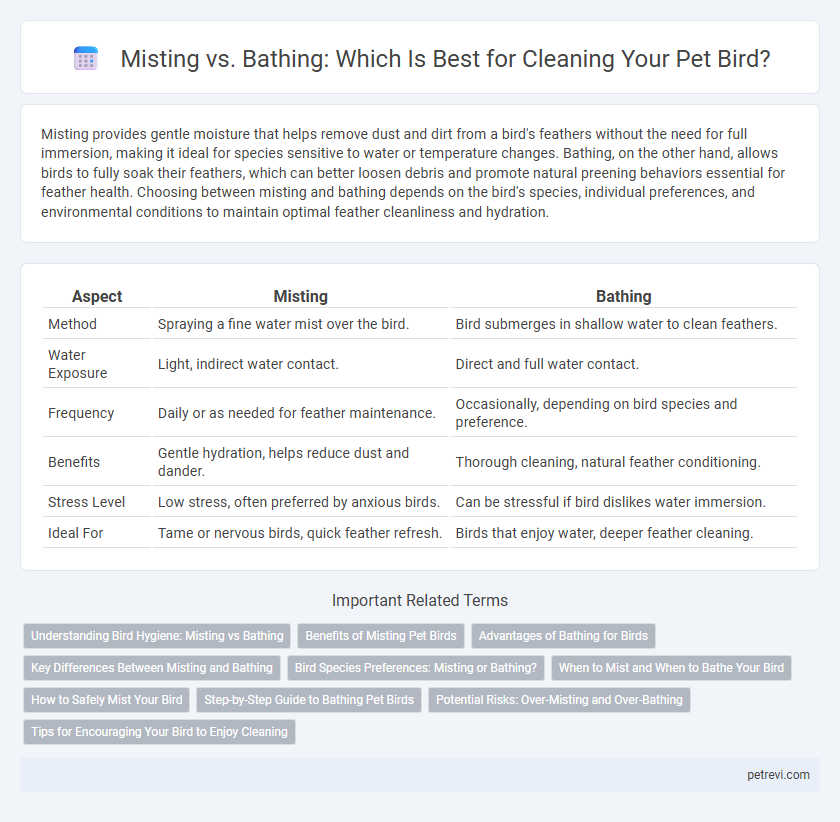Misting provides gentle moisture that helps remove dust and dirt from a bird's feathers without the need for full immersion, making it ideal for species sensitive to water or temperature changes. Bathing, on the other hand, allows birds to fully soak their feathers, which can better loosen debris and promote natural preening behaviors essential for feather health. Choosing between misting and bathing depends on the bird's species, individual preferences, and environmental conditions to maintain optimal feather cleanliness and hydration.
Table of Comparison
| Aspect | Misting | Bathing |
|---|---|---|
| Method | Spraying a fine water mist over the bird. | Bird submerges in shallow water to clean feathers. |
| Water Exposure | Light, indirect water contact. | Direct and full water contact. |
| Frequency | Daily or as needed for feather maintenance. | Occasionally, depending on bird species and preference. |
| Benefits | Gentle hydration, helps reduce dust and dander. | Thorough cleaning, natural feather conditioning. |
| Stress Level | Low stress, often preferred by anxious birds. | Can be stressful if bird dislikes water immersion. |
| Ideal For | Tame or nervous birds, quick feather refresh. | Birds that enjoy water, deeper feather cleaning. |
Understanding Bird Hygiene: Misting vs Bathing
Misting and bathing are essential methods for maintaining bird hygiene, each offering unique benefits for feather health and cleanliness. Misting involves gently spraying water over the bird, helping to hydrate feathers and remove dust while minimizing stress, making it ideal for species sensitive to full baths. Bathing allows birds to immerse themselves in water, promoting deeper cleaning, natural feather preening, and temperature regulation, crucial for species that enjoy swimming or soaking.
Benefits of Misting Pet Birds
Misting pet birds provides gentle hydration that mimics natural rainfall, promoting healthy feather condition and skin without the stress of full immersion. This method helps maintain optimal humidity levels, reducing the risk of respiratory issues common in dry environments. Misting also encourages preening behavior, which is essential for keeping feathers clean, aligned, and waterproof.
Advantages of Bathing for Birds
Bathing provides birds with thorough cleaning by allowing water to reach their feathers and skin, effectively removing dirt, dust, and parasites. This natural method helps maintain optimal plumage condition, enhances preening behavior, and supports overall feather health. Regular bathing promotes better hydration of feathers, contributing to improved insulation and flight efficiency in birds.
Key Differences Between Misting and Bathing
Misting involves gently spraying water onto a bird's feathers to simulate natural dew, promoting feather health without fully soaking the bird, which helps prevent chilling in cooler environments. Bathing requires the bird to submerge or stand in water, allowing thorough cleaning of feathers, removal of dirt, and aiding in the regulation of body temperature. Key differences include the level of water exposure, with misting providing a light moisture layer and bathing offering a deeper, more effective cleansing process essential for maintaining optimal plumage condition.
Bird Species Preferences: Misting or Bathing?
Parrots and finches often prefer bathing in shallow water, which helps maintain their feather health and removes dust and parasites effectively. Small bird species like budgerigars and canaries generally respond well to regular misting, providing gentle hydration without the stress of full immersion. Waterfowl, including ducks and swans, naturally favor bathing as a primary cleaning method, utilizing their aquatic habitats to keep feathers waterproof and vibrant.
When to Mist and When to Bathe Your Bird
Misting is ideal for regular maintenance and hydration, especially in dry environments or during molting, while bathing is more appropriate when your bird's feathers are visibly dirty or after exposure to dust and debris. Misting can be done daily or several times a week using a fine spray to mimic natural rain, whereas bathing should be less frequent, typically once a week or as needed, depending on the species and individual bird's habits. Observing your bird's behavior and feather condition helps determine the best timing for misting or bathing to ensure optimal hygiene and skin health.
How to Safely Mist Your Bird
To safely mist your bird, use lukewarm water with a fine spray nozzle to create a gentle mist that mimics natural rain without soaking feathers. Avoid spraying directly into the bird's face, eyes, or ears to prevent stress and potential health issues. Ensure the bird's environment stays warm and draft-free after misting to allow feathers to dry properly and maintain optimum feather health.
Step-by-Step Guide to Bathing Pet Birds
Begin the bathing process by filling a shallow bird-safe dish with lukewarm water, ensuring it is not too deep to prevent drowning risks. Gently place your pet bird in the water, allowing it to splash and bathe naturally while providing a calm environment to reduce stress. After bathing, carefully towel-dry your bird and keep it in a warm, draft-free area until fully dry to maintain optimal health and feather condition.
Potential Risks: Over-Misting and Over-Bathing
Excessive misting can cause respiratory issues and chill birds, leading to stress and potential infections. Over-bathing may strip essential oils from feathers, resulting in dry skin and compromised plumage health. Maintaining balanced cleaning routines prevents these risks and supports optimal bird hygiene and well-being.
Tips for Encouraging Your Bird to Enjoy Cleaning
Offer a shallow water dish at room temperature for birds to bathe comfortably and place a misting spray lightly overhead to mimic natural rain without stressing the bird. Use gentle, consistent routines and positive reinforcement, such as treats or soft praise, to help your bird associate cleaning with enjoyable experiences. Introduce misting or bathing during calm, warm periods and gradually increase exposure to build trust and ease anxiety around water.
Misting vs Bathing for Bird cleaning Infographic

 petrevi.com
petrevi.com